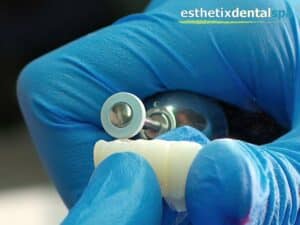Step-by-Step Guide: What To Expect During The Dental Implant Procedure
If you’re missing a tooth or struggling with a damaged one, you might be wondering if dental implants are a good option to solve this issue. Luckily, you found the right place to learn all about this long-lasting solution that’s been increasing in popularity in recent years.
Read this guide to learn about each step of the dental implant process, from initial consultation to the final, beautiful result, so you can step into your trusted dental clinic in Washington Heights without any stress.
Understanding Dental Implants: What Are They & How Do They Work?

Many patients prefer implants to avoid a bridge that will need to be replaced in a few years or the discomfort of dentures. Implants look, feel, and function like natural teeth, making them an especially good option if your missing tooth is at the front of your mouth or very visible.
A dental implant has three basic parts:
- Threaded post: Think of this as an artificial tooth root. During oral surgery, a practitioner inserts it into your jawbone.
- Abutment: This is a small connecting post. It screws into the threaded post and extends just past your gums. It serves as the base for your new prosthetic tooth.
- Restorations: These are any prosthetics used to repair or replace teeth. Crowns, bridges, and dentures are among the most common dental implant restorations.
Before visiting your dental clinic, remember to first analyze if you’re a good candidate for it. Alternatively, consult your dentist for more personalized information.
Are You a Candidate For Dental Implants? Key Factors To Consider
Dental implants are surgically implanted into your jawbone and act as the roots of missing teeth. Because the titanium in the implants integrates with your jawbone, they will not slip, generate noise, or cause bone injury, as fixed bridgework or dentures can. And the materials cannot deteriorate like your natural teeth.
Dental implants may be ideal for you if you:
- Have one or more missing teeth
- Have a fully developed jawbone
- Have enough bone to secure the implants or can undergo a bone graft
- Maintain healthy oral tissues
- Do not have any health conditions that may interfere with bone healing
- Are not able or willing to wear dentures
- Want to improve your speaking ability
- Are prepared to commit several months to the procedure
What Are The Advantages Of Dental Implants?
Implants offer a variety of advantages and provide a permanent replacement option for missing teeth. Here are some of the benefits:
- Promotes the health of surrounding teeth by maintaining the shape and strength of the jawbone.
- Restores your bite, making it easier to chew and talk properly.
- Prevents facial structure degradation, which is likely to happen if the missing tooth root is not replaced with a dental implant stud.
- Prevents tooth decay and bacterial buildup by filling gaps in the mouth.
Just remember that all these benefits are possible only with a reliable dentist, so do proper research before receiving this treatment anywhere.
What Are The Steps In The Dental Implant Process?
The process will take several months and operations to guarantee that the implant fully integrates with the jawbone and becomes a permanent fixture. Healing between these procedures makes up most of the time for the implant process.
Here’s how it goes:
- Initial incision: Your dental implant specialist will make a small cut in your gums where the implant will be placed in order to gain access to the tooth socket.
- Implant insertion: Your dentist will place the metal post right into your bone, then suture the area and allow it to heal for three to six months.
- Exposing the implant: Once the area has healed for several months, your dentist will make a new cut to expose the implant and screw a collar, called a healing cap, on top of the stud.
- Healing cap removal: A few weeks later, you’ll return to your dentist for the healing cap removal.
- Abutment and crown placement: The final stage of the dental implant procedure involves the insertion of the abutment and then the dental crown.
Exploring the One-Stage Dental Implant Option: Is It Right For You?

This approach offers a faster implant process with fewer surgical procedures; however, there is a slightly higher risk of complications because the body does not have time to acclimate itself to the placement of the implant. Your dentist can help you determine which procedure might be right for you.
Consult With New York’s Leading Cosmetic Dental Clinic
If you’re wondering whether dental implants might be the right choice for you, schedule your appointment with Esthetix Dental Spa. Our experienced dentists provide personalized treatment for each of our patients to promote optimal outcomes and a smile you’ll love.
With a dedication to the highest standards of care and a convenient location, Esthetix Dental Spa is recognized as one of the leading dental implant centers in Washington Heights, NY. Contact our office today to schedule your appointment!
Esthetix Dentist, NYC’s Dental Implant & Cosmetic Specialist
285 Fort Washington Ave,
New York, NY 10032
Phone: (212) 795-9675
Website: http://esthetixdentalspa.com/

